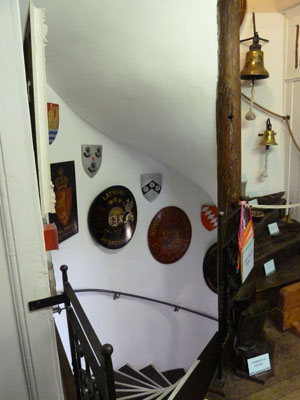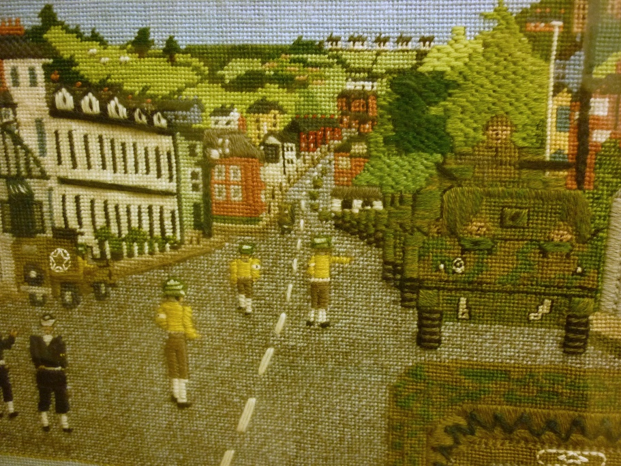The Lobby
entrance
As you come into the museum through the unassuming doorway in The Butterwalk, don’t just rush ahead. There’s a whole cabinet on your left that you’re in danger of missing. Included here is information about the Newcomen Atmospheric Engine, the first practical steam engine, which was invented in Dartmouth. We are pleased to claim Dartmouth as the starting point of the Industrial Revolution that changed the world but relieved that the absence of local deposits of coal or iron ore kept away the dark satanic mills. Those interested in the Newcomen Engine can see a real one at the nearby visitor centre, brought back from the Midlands in 1963 to its ancestral beginnings.
As you walk towards the stairs notice two things about them. The first is that they spiral anticlockwise. This is normal non-military practice. If this were a castle the stairs would rise clockwise to favour right-handed swordsmen defending from above. The second is that the central spine is an old ship’s mast. This reuse of timbers is common to all old buildings in Dartmouth; it once had extensive ship-building.

reception & landing
To start your tour, a steward will usually summarise the layout and point you in the right direction. An alternative is to buy a guidebook (at very modest cost) which describes each room in fuller detail and is copiously illustrated.
For visitors with younger children there are several possibilities. You can photograph them in the stocks or send them off with one of the many expertly-designed quizzes. In the Henley Study there are microscopes and other items that children are welcome to use. Or they can help open the drawers below the displays.
The corridor has a giant golden key overhead towards its end. This was the sign outside William Henley’s ironmonger shop and here it is outside the Henley Study. On the left of the corridor are examples of woolwork pictures by sailors. Opposite on the right is a series of 16 embroidery panels, woven by ladies of the town, and depicting events associated with D-Day. The last item on this side is an extract from the Dartmouth and Brixham Chronicle of 2 March 1877 which says why Dartmouth was chosen for the new Naval College. Perhaps more revealingly, it states why the other ports were not.

This tapestry of US troops and vehicles is just past the Guildhall, looking along Victoria Road towards the top of the town.
Placed convenient for those about to go downstairs, there is the visitors’ book. Your entry and any comments are much welcomed. Comments on social media are also appreciated. Also convenient for visitors is a toilet, but this in on the upper floor landing.
upper landing
This extension to the Museum came into use in 2020 to coincide with the Mayflower 400 commemorations. There are two spectacular exhibits in the upper landing. One is a good-sized newly painted elevated view of Dartmouth as it was thought to be in 1620. The other is a fine ship model of the Cutty Sark. Those who rush past the real thing in the London Marathon can take time with this model to consider what features made it the fastest large sailing ship of its time.

